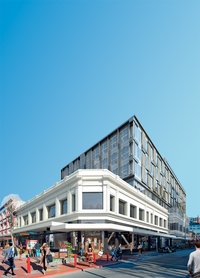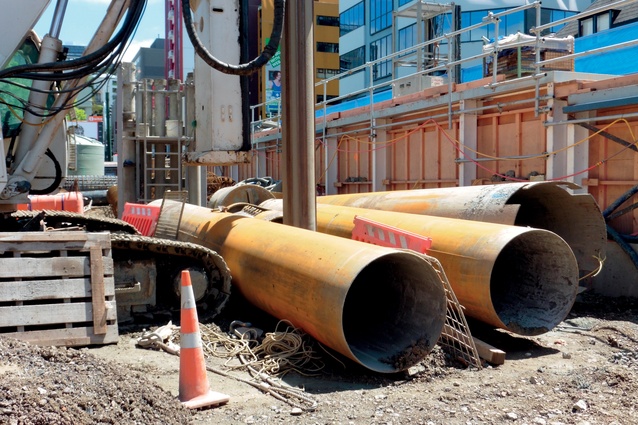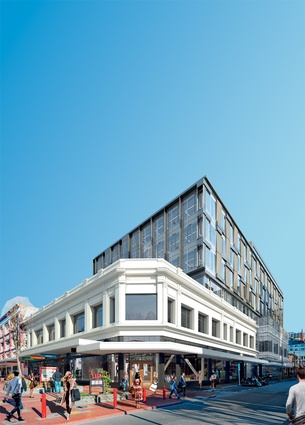On the cusp of change
Building is turning an historic corner at the entrance to Wellington’s Cuba Mall. Willis Bond & Co’s $80 million joint campus for Whitireia and WelTec polytechnics at the junction of Cuba and Dixon Streets will house more than 1000 New Zealand and international students. The six-storey campus, dubbed “Cuba Central” is part of the development of a wider project that includes retail spaces on the ground floor of the building. It is designed to 130 per cent of the new building standard.

To make way for the modern complex, the earthquake-prone building that was once Te Aro House, Woolworths and then Deka has been demolished; however, the façade is being retained and strengtened for heritage reasons. Upper Cuba Street is notable for its Edwardian buildings. In lower Cuba Street a number of buildings remain from the post-WW1 period.
Both the building and the Cuba Central site are associated with the early development of retail business in Wellington. Mary Taylor, an early 19th century feminist, businesswoman and friend of novelist Charlotte Brontë, built a drapery and clothing shop there around 1845. She sold the property and it eventually passed to James Smith, who named the building Te Aro House.
After a major fire in 1885 a larger, brick masonry store with an ornamental, Italian-influenced façade was built on the site. Architect Thomas Turnbull designed fire protection devices such as brick walls dividing departments, and perforated pipes running down the ridges of the building, which would enable the building to be flooded in the event of fire.
The building changed hands several times, passing to owners such as Hannah Ltd, Woolworth NZ and L.D. Nathan who wrought further changes. The facades and interior were remodelled, a tower and some exterior ornamentation was removed. The building was categorized as a much-modified, stripped, Classical-style commercial building.
Stage one of the project was nearing completion when Progressive Building visited the site and Jurgen’s long reach excavator was crunching through the last standing interior wall at a safe 20-metre distance.
Wade Pulford, site manager for main contractor LT McGuinness, said they have moved progressively through the demolition phase, halting at times to build temporary supports for the façade. “The demolition of the old building was done in a staged sequential way to make sure it stayed standing as we went through. I think this is the first time we have used the long reach. It’s been kept busy in Christchurch,” Pulford said.

The façade and the structure behind it have presented a number of challenges, particularly along Dixon Street where the façade was removed in panels to allow pile-driving machinery into the site. Behind the façade, the supporting structure of the former Deka building was brick with additions of concrete and steel. But they were excavating into largely unknown territory.
“Over time it had been chopped and changed around. Every time we pulled down a wall there was a surprise – either something there we didn’t expect or something not there that should have been. The façade, for example, used to have archway windows, but they had been in-filled with brick and concrete and made into square windows. Some bricks were from the 1950s,” says Pulford.
Two large cast iron boilers were discovered behind another wall and specialists had to be brought in to remove a considerable amount of asbestos from the lagging around heating-pipes. The condition of the façade was checked to make sure there was enough mortar between the bricks; another challenge involved setting up the temporary structural steel work to hold it.

“Drilling and epoxying it into the brick, and making sure it was going to hold together, was a big challenge. There were a lot of workshops and regular weekly meetings between LT and Dunning Thornton as we progressed through.”
Once the façade panels were cut, they were craned to the opposite side of the site – next to the Farmers building – and placed on a five-degree lean to keep them safe. Before the panels could be lifted the team had to calculate their weight. Lifting the first panel was cause for some breath-holding, says Pulford. “With the mobile crane holding it we didn’t want it to be too under or over weight. If you cut it free it could pop up; if it was too heavy it could fall down. But the estimates were bang on within half a tonne.”
The façade panels are 6.3m high and range from 3.5 to 4m wide with the heaviest weighing in at 21.5 tonnes. The lightest weighed 9.6 tonnes. Pulford’s team made the panel cut delineation between the windows – a T-section that included the top finial, the parapet and the columns.
When new structure is completed, the restored façade panels will be reinstated, aligned with the façade that has been left in place, and with the new building grids. It will be temporarily suspended four metres above ground level before being incorporated into the new structure.
The façades on both the Cuba and Dixon street fronts will be sprayed behind with concrete, drilled and reinforced with epoxy resin then tied back into the new structure with weld plates and structural steel and sprayed again with 250–350mm of concrete to hold it all together.
“The next phase is to continue with our foundation beams from Cuba Street heading towards Victoria Street. The structural steel is being shop-drawn and we won’t be too far away from getting that manufactured. There is a lot of sequencing around the first stage of the building and the heritage façade – placing the steel to suit the existing steel beams and tying it all back together as we go through. There will be a lot of site measuring to get it to work. After that it will be on to the new build,” says Pulford.
















